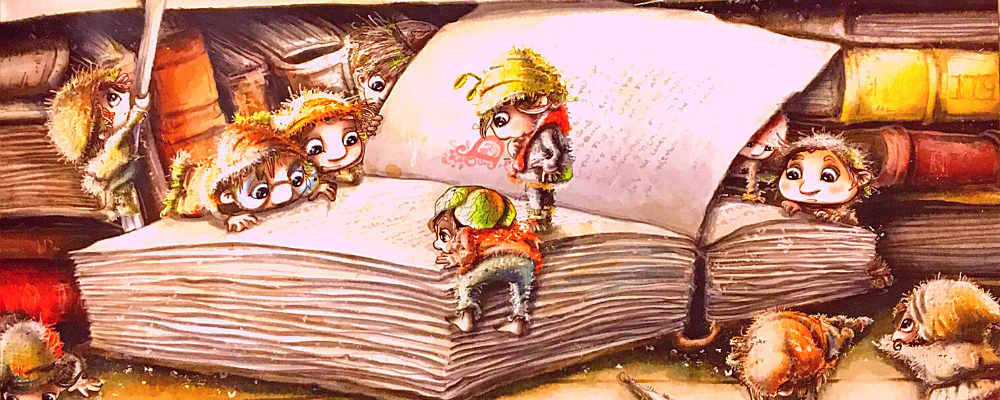It is a known fact that some of Nâzım Hikmet’s texts are published as children’s book separately or in groups apart from his four books series named as Tales and Stories.
It is a known fact that some of Nâzım Hikmet’s texts are published as children’s book separately or in groups apart from his four books series named as Tales and Stories. Among these, children’s picture book In the Palace, which is published in August 2017, is actually a part from the text named as “Adventures of Forest Gnomes”. The text which is about forest gnomes’, who are imaginary creatures, visit to a palace, and it points out class discrimination and kind of criticises this discrimination. In this context, the setting in which narration takes place and the structure of plot resembles characteristics of carnivals and fairs which Bakhtin underlines when he explains the carnival concept as being functional in making expansions to literary genres.
The first part in this book, which consists of a single adventure of gnomes, begins with a short introduction of them. There is a huge diversity among these gnomes, even though they are not realised by anyone. With the variety of “gnome society” ranging from Chinese Çi-Ka-Çi to a black, Indian or an Eskimo, from Wise and Dumb who are siblings and do not resemble at all and finally from a painter called as Brushlet to a doctor named Ointment Box, a kind of cosmopolitan society structure is set. Gnomes are a society in some way, though being created imaginary. Adventures of these gnomes were conducted by the leadership and narration of Yusufçuk, who describes himself as the nimblest, the most intelligent and the bravest of them all. These creatures, who are believed to be some kind of insect, cicada or grasshopper, live in the forest and bear some kind of heroic characteristics. Among these we see some positive characteristics, which do not give any room to malignancy, such as “leaving the forest and wandering around the world, taking care of human beings, doing good deeds, giving a helping hand to the good, laughing and having fun, and sometimes punishing for malignancy” (1). These characteristics of gnomes are actually, as usual in most of children’s literature texts, are the same as the imaginary world image which is set on leisure time activities without mentioning any of the details regarding their daily struggles for maintaining their lives. As for this world image, there are close similarities with Bakhtin’s carnival.
Carnival is a kind of ceremony in which people get away from their real living conditions on specific occasions determined as festival and where they usually get rid of their identities and take part on an epic ground: “One of the essential elements of folk entertainment was imitation, that is the renewal of clothes and social image. Another basic element was reversion of hierarchical levels: such as joker’s being declared as king” (102). The commune life of gnomes represents carnivalistic features with some of its characteristics and their small trip in In the Palace represents a small example of carnival model. After seeing the palace in their visit to city they agree upon the idea of entering it with the urge of their curiosity. They find their way to palace with encouragement of Yusufçuk when they are concerned about being caught by guards. In the text there are not any details regarding the people who live in the palace and its owners, actually. The fact that there are not any details about this, and that no one is seen except for the gnomes, means something. Let alone being seen, even names of people who are supposed to live in the palace such as king are not mentioned throughout the text, whereas venue of the story is “palace” and that it points beforementioned people. When entering the palace, only information given is that it is protected by the guards, it is emphasised that this action of gnomes was secret and violating the rules but cunningly: “The palace was full of gnomes as if there was a raid by ants. We were the owners of the palace anymore.” (Nâzım Hikmet 7). At this point, Bakhtin’s appeal of the folk to imitation and renewal of social image during carnival for having fun, becomes valid. Indeed, “Lower and middle class, clergy, religion instructors and students, and members of corporations were among actual participants of these folk entertainments.” (Bakhtin 103). Starting from the first minute gnomes start imitating the real owners of the palace and these people, who are ordinary and never noticed by others in a sense, take a step to a different ritual. This ritual has parallel characteristics with carnival. According to Bakhtin,
Carnival is a ceremony that no one gets on the stage and where there is no separation between performers and spectators. Everyone is an active participant, everyone joins to act of carnival. Carnival is neither watched nor performed in a proper way, participants live in carnival, as long as the rules for carnival goes on they live according to these, which means that they maintain a carnivalesque life. Since carnivalesque life is an extraordinary life, it is somehow “a reversed life”, it is “the reversed side of the world.” (238).
During this period gnomes takes the position of palace’s actual owner and have fun as if they are in a carnival at “the reversed side of the world”. They narrate this situation as “We were kicking and stamping on silk rugs, under brocade curtains and golden cornices. We were opening huge gilded doors, going in and out the rooms.” (Nâzım Hikmet 8). Discourse of Yusufçuk, the gnome character which stands out from the very beginning as others have fun among themselves, is remarkable. According to Bakhtin,
Ordinary, non-carnivalesque structure of life and laws, prohibitions and restrictions that set its order goes into abeyance: at the very first place there are hierarchical structure and all kinds of intimidating, respect, piety and etiquettes related to this structure –everything that emerges from socio-hierarchical inequality or another type of inequality among people (including the age). All distances among people go into abeyance and a special carnival category enters into force: a free, intimate, familiar, sincere and warm contact among people (238).
Yet, Yusufçuk seems to act as the pushing force as this warm contact realised in In the Palace. At one of the scenes, Yusufçuk looks at the other gnomes and despises Little Sailor and Miller: “Well, they did not have any good clothes to take a look at. There was only me to look at the mirror and feel proud of its clothes. But they did not let me go near the mirror.” (Nâzım Hikmet 14). Stating the importance of clothes, fashion and appearance during carnivals would be just repeating what is already known. Except from this, throughout the text narrator’s voice goes along with Yusufçuk and appeals to the reader, and being given a position in which he has a privilege compared to others, he acts a character that always puts himself into first position. It would not be strange if he, who tends to get above himself, was regarded as a lower-class person who takes the position of the king or another noble person. As a matter of fact, a behaviour of him is consistent throughout the text whenever he encounters a situation where his actions are limited or mocked: pushing gnomes to the way he wants them to be by provoking them. At this point, the carnival of In the Palace gets to separate from Bakhtin’s. All other gnomes are named according to either on their characteristics or even on their awkwardness whereas Yusufçuk has a special name and it also is like a sign that separates him from others and takes him to a relatively superior position. Throughout the narration each provocation of Yusufçuk makes gnomes act in a way which reinforces carnivalesque elements. “People, separated from each other in daily life by nonpermeable hierarchical obstructions, contact with each other free and easy in carnival square. Likewise, warm, sincere contact category is also responsible for special organization style of massive actions, free carnival gestures and unfettered carnivalesque parole.” (Bakhtin 238). At this point, since the noble are not mentioned in the text, this does not create a hierarchy between the folks and the nobles, so population takes step within the population itself and this completely highlights a point regarding the text. Yusufçuk does not stay only as a part of the population, he develops his character, becomes an individual. Yusufçuk’s leading gnomes who mocks with him to the ball room in order to distract them takes place in this way. Here gnomes have a compete carnivalesque entertainment: “Probably this ball room of the palace has never witnessed that much bright ball before. We danced every kind possible. Each dance from Zeybek to foxtrot performed joyfully. We did not have harmonica. But as we jumped and danced chandeliers were swinging and hitting each other and they were drumming us as if they were a nice orchestra.” (Nâzım Hikmet 20). After this tiring entertainment they all try to find the bedroom in order to have some rest and it is again Yusufçuk who finds the room due to his leadership jumps on the bed and provokes others to do so, in other words he is again the one to be imitated by others. “Would other gnomes stand there and stare?” (22). But after this action they start to get signals that their “carnival” comes to an end. The bed is broken, gnomes are wounded and doctor gnome tries to treat them. Upon the sudden sound that is heard when the bed was broken, they rush to leave the palace with the leadership of Yusufçuk so that they can escape from the palace’s people whom they think chasing after them.
With their leaving, the carnival comes to an end officially and during this period when gnomes managed to imitate the real owners and behaved as if they were the real owners of the palace, even if it is for a limited period they took the position of these people who are hierarchically above them and so they were able to have fun freely as if there were not any rules. Apart from all these resemblances, the most essential indicator which separates adventure of In the Palace and Bakhtin’s carnival is that here they had fun in a carnival which was not approved by the noble but was a secret, so it violated rules, and this revolt is Nâzım Hikmet’s signing this book completely as his own book. As long as there are some people like Yusufçuk, a characterised protagonist, a free carnival can be created not only determined by the noble but also sometimes only by themselves. But unfortunately, what is noticed at the last point is that he actually sets a hierarchy by his own free will among gnomes and puts it opposite to order’s hierarchy, and that must be the parody of the text.
Bibliography
Bakhtin, Mikhail. Karnavaldan Romana: Edebiyat Teorisinden Dil Felsefesine Seçme Yazılar. İstanbul: Ayrıntı
Yayınları, 2001.
Nâzım Hikmet. Sarayda. Res.Ayşe İnan Alican. İstanbul: Yapı Kredi Yayınları, 2017.

